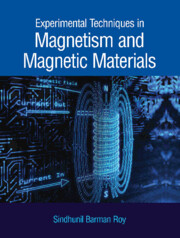Book contents
- Frontmatter
- Dedication
- Contents
- Preface
- I Introduction to Magnetism and Magnetic Materials
- II Basic Phenomenology of Magnetism
- III Experimental Techniques in Magnetism
- Appendix A Magnetic Fields and Their Generation
- Appendix B Units in Magnetism
- Appendix C Demagnetization Field and Demagnetization Factor
- Index
5 - Magnetically Ordered States in Solids
Published online by Cambridge University Press: 27 October 2022
- Frontmatter
- Dedication
- Contents
- Preface
- I Introduction to Magnetism and Magnetic Materials
- II Basic Phenomenology of Magnetism
- III Experimental Techniques in Magnetism
- Appendix A Magnetic Fields and Their Generation
- Appendix B Units in Magnetism
- Appendix C Demagnetization Field and Demagnetization Factor
- Index
Summary
In this chapter, we shall study different types of ordered magnetic states that can arise as a result of various kinds of magnetic interactions as discussed in the previous section. In Fig. 5.1 we present some of these possible ground states: ferromagnet, antiferromagnet, spiral and helical structures, and spin-glass. There are other more complicated ground states possible, the discussion of which is beyond the scope of the present book. For detailed information on the various magnetically ordered states in solids, the reader should refer to the excellent textbooks by J. M. D. Coey [1] and S. J. Blundell [4].
Ferromagnetism
In a ferromagnet, there exists a spontaneous magnetization even in the absence of an external or applied magnetic field, and all the magnetic moments tend to point towards a single direction. The latter phenomenon, however, is not necessarily valid strictly in all ferromagnets throughout the sample. This is because of the formation of domains in the ferromagnetic samples. Within the individual domains, the magnetic moments are aligned in the same direction, but the magnetization of each domain may point towards a different direction than its neighbour. We will discuss more on the magnetic domains later on.
The Hamiltoninan for a ferromagnet in an applied magnetic field can be expressed as:
The exchange interaction Jij involving the nearest neighbours is positive, which ensures ferromagnetic alignment. The first term on the right-hand side of Eqn. 5.1 is the Heisenberg exchange energy, and the second term is the Zeeman energy. In the discussion below it is assumed that one is dealing with a system with no orbital angular momentum, so that L = 0 and J= S.
In order to solve the equation it is necessary to make an assumption by defining an effective molecular field at the ithsite by:
Now the total energy associated with ith spin consists of a Zeeman part gμB_Si._B and an exchange part. The total exchange interaction between the ith spin and its neighbours can be expressed as:
The factor 2 in Eqn. 5.3 arises due to double counting. The exchange interaction is essentially replaced by an effective molecular field Bmf produced by the neighbouring spins.
- Type
- Chapter
- Information
- Publisher: Cambridge University PressPrint publication year: 2023

